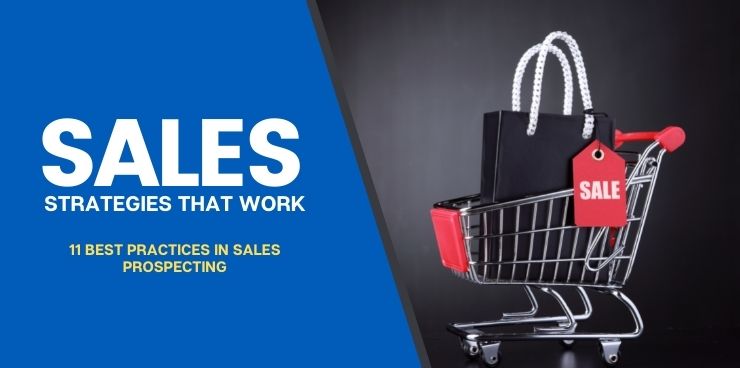Sales prospecting is a little like prospecting for gold. It’s hard work, and there’s no guarantee of success, but sometimes you stumble on something amazing. However, in a lot of cases, discovering a lead may turn out to be more profitable than finding gold.
Defined as the process of having sales representatives attempt to connect with leads, sales prospecting is essential for your business. You can’t make sales without someone to sell to, after all.
Sales prospecting isn’t always easy, but it’s worthwhile. If you’re ready to revolutionize your business, these are the best practices in sales prospecting that you need to know.
Sales Prospecting Best Practices
Everyone you ask will have different ideas about the best way to conduct sales prospecting activities. Your business, sales team, and products are unique too, so what works for one person may not work for you. Despite all of that, there are a few pieces of advice that apply almost across the board.
Identify Your Ideal Customer Persona
One of the most vital best practices in sales prospecting is identifying and documenting your ideal customer persona. We mean that bit about creating documentation, too. Sales personas should be well-thought-out digital or physical documents. That way, your sales team can reference them.
When you know the pain points and constraints your leads face, you can sell to them more effectively. You can also quickly decide whether a lead matches your company.
If you don’t know your ideal customer persona, you’re going to waste your time on leads that won’t ever convert.
It might be tempting to focus on as many leads as possible. However, a focus on quality over quantity tends to produce better results.
Implement Automation Wherever Possible
Think about all of the tedious, repetitive tasks your sales team performs daily. Sending emails, qualifying leads, data entry— your team spends a lot of time doing things other than selling.
These activities are all necessary, but do your team members need to be the ones performing them? With recent technological developments, they don’t.
We recommend implementing automation wherever you can. That way, your team can focus on the complex and rewarding tasks machines can’t do.
Make Warm Calls Rather Than Cold Calls
While sometimes considered antiquated, cold calling has its place in your sales process. However, when it comes to the best practices in sales prospecting, warm calls are better.
A warm call is one in which you reach out to someone who has already expressed interest in your company. That way, you can focus on building a relationship. It’s far more productive than getting hung up on a few words in your script.
Events Are Great Networking Opportunities
With the United States slowly reopening in the wake of the COVID-19 pandemic, events are starting to happen in person. That’s exciting news for a lot of reasons, including the networking opportunities they’ll offer.
Conferences and other events are great for salespeople looking to interact with potential clients. Whether you speak, manage a booth, or attend a mixer, there are chances to prospect.
Select the events you attend carefully. If they’re not relevant to your industry, it will not be an efficient use of your time.
Be an Industry Expert
Your potential clients have questions, and you can be who they turn to for answers. You’ve probably already got the knowledge; you just need to connect with an audience.
Becoming an industry expert is difficult of the best practices in sales prospecting. Still, it’s well worth the effort.
The best way to do so is to start writing blog articles and guest posts. You can also speak at events like conferences and trade shows.
Positioning yourself as an expert within your industry boosts your reputation. It also increases your company’s visibility.
Don’t Be Afraid To Ask for Referrals
Asking for a referral can seem intimidating. You don’t want to take up someone’s valuable time, and rejection never feels good.
However, most customers are happy to give referrals. Moreover, people who find you through a referral tend to spend more money with your company.
You can encourage referrals by creating a formal referrals reward program for your current customers. This has the added benefit of letting them know you value their opinion as well as their business.
Get Involved in Social Selling
When we say social selling, we’re referring to social media. In today’s market, it’s inescapable. If you haven’t already, start researching which social media platforms might be helpful to you. The audience you find on LinkedIn will be much different than the one you access through Instagram.
Social media accounts allow you to interact with your audience on a more personal level if you’re selling to individuals. If you’re making B2B sales, LinkedIn especially lets you stay connected effectively and without much effort.
Deliver Relevant, Customized Content for Your Audience
It was Bill Gates that first said content is king back in 1996, and that’s still the case. Content creation is one of the most consistent practices in sales prospecting.
Delivering relevant, customized content to your audience on time is critical. Content is a way to provide value to your leads, drawing them closer to your company.
It attracts their attention, keeps them engaged, and shows that you’re paying attention to their needs.
Our idea of channel alignment — your sales and marketing teams working together with your web presence — comes into play here.
The people on your marketing team are going to be the ones producing the content. Your salespeople leverage it. Often, it appears on your website or social media platforms.
Without one of those channels, content is less effective.
Focus Your Efforts on the Right Prospects
Let’s circle back to the idea of quality over quantity when it comes to prospects. When you’re prospecting, you’re trying to start a relationship with a potential customer. Not everyone out there has an interest in a business relationship right now, though.
That’s alright. Consumers have varied needs, and you can’t meet all of them. However, you can meet some of them, and that’s what you should focus on.
When you dedicate your efforts toward connecting with qualified leads, your success rate will go up.
To find qualified leads, you need two things: set criteria and information. Part of the criteria you develop will be your ideal customer persona that we discussed earlier. Beyond that, there aren’t any set criteria. It will depend on the unique nature of your business.
As far as information goes, leads generally aren’t considered qualified until they reach out and offer their information. An example would be someone who provides their email address to subscribe to your newsletter.
It also helps to have some idea of a lead’s budget and the problems they face.
 Turn Prospecting Into a Regular Habit
Turn Prospecting Into a Regular Habit
The business world as a whole loves to talk about building habits for success. If you’re in sales, one of those habits should be sales prospecting.
It’s tempting to put off prospecting until the last minute and then do it all at once. Cramming only barely works for students, though; it’s not what’s best for your company.
Instead, start building a sales prospecting habit. You probably have a quota of some sort to fill. Take that number, and look at the length of time you have to do it. Then, set aside a daily or weekly time for prospecting activities and stick to it.
Before long, you will have built a habit.
Always Follow Up With Your Prospects
The last of our best practices in sales prospecting is to always follow up. That sounds simple enough, right? In a way, it is. However, you need a bit more information than that.
Understanding the typical journey a customer takes with your company is essential for follow-up activities. When you know where someone is in the customer journey, you can tailor your follow-up efforts.
You can automate some of these processes. For example, has it been a month since someone last interacted with your company? You might be able to program your customer relationship management program to email them automatically.
Have you gotten an email saying something along the lines of “we miss you!” that offered a discount for returning? That’s a follow-up as well as an excellent use of automation.
How Many No’s To Get a Yes in Sales?
Sometimes, it feels like the only thing you hear as a salesperson is different iterations of the word no. That’s part of the job, but it’s not pleasant by any means. However, your tenacity will pay off. Get ready for one of our favorite statistics.
After hearing no four times, 92 percent of salespeople give up. However, 80 percent of sales require at least five follow-ups.
You can see how there’s a disconnect between those numbers.
If you’re feeling discouraged after another rejection from a lead, don’t give up. It’s part of the process.
If you’re looking to:
- Increase your leads.
- Improve the sales training your team receives.
- Recruit top sales talent.
Selling Revolution is here for you. To connect with us, book a call now. We can’t wait to get started!



 Turn Prospecting Into a Regular Habit
Turn Prospecting Into a Regular Habit